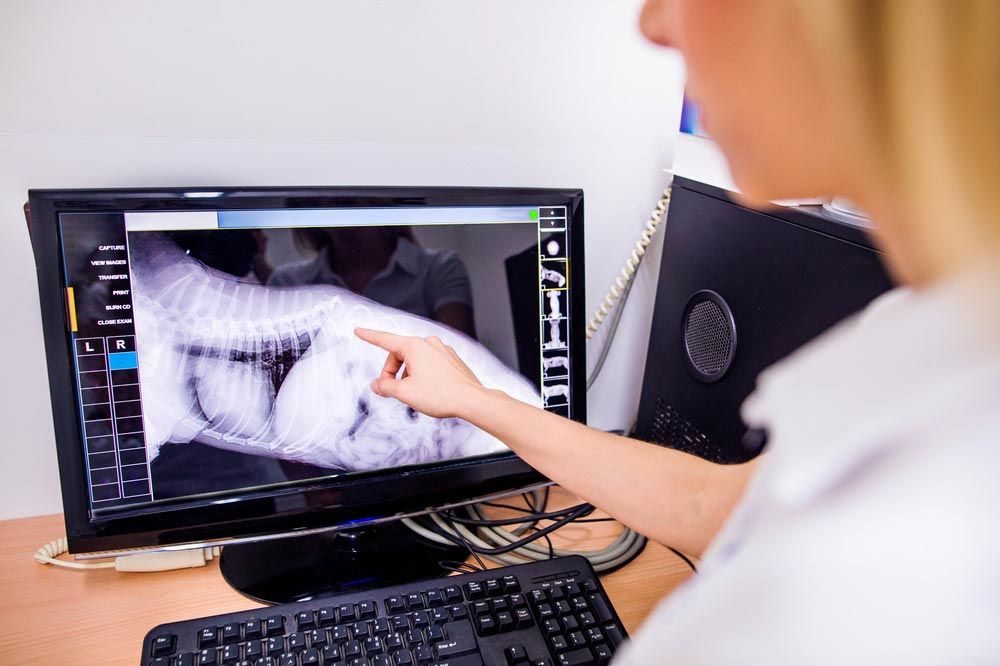Digital Pet Radiography
Think your pet may have broken a bone? Worried they swallowed something they shouldn’t have? Our veterinarians are here to help! At Killarney Vale Veterinary Clinic on the Central Coast, we’re equipped with digital x-rays and computed radiography. We can use this tech to see what’s going on inside your pet’s body without having to perform surgery.
Animal x-rays help us diagnose and treat a wide variety of conditions including broken bones, arthritis, bladder stones and lung disease. We can also use them to locate foreign bodies, which is great news if you’ve got a dog that thinks everything is a treat!
Get in touch with us today on
(02) 4334 2002.
Computed Radiography Benefits
Our veterinarians use computed radiographs to carry out health checks. This state-of-the-art technology has numerous benefits compared to standard x-rays. They include:
- Computed radiography produces images with higher resolutions
- Pictures don’t require developing & are available immediately
- Images can be adjusted & enhanced for accurate diagnoses
- Results can be shared with specialists easily if expert readings are necessary
- Images can be displayed & modified on iPads to show you your pet’s condition
- Computed radiography exposes pets to less radiation than regular x-rays
Frequently Asked Questions
-
What happens when your pet comes in for surgery?
- The vet will clip the fur around the surgery site.
- Your pet will receive a blood test.
- The vet will provide a check-up – they’ll perform vitals, checking heart rate, temperature, pulse, mucus membranes & respiratory rate.
- Your pet will undergo sedation to keep them calm, which includes pain relief.
- The vet will place a catheter.
- The vet will hook your pet up to IV fluids to help manage their blood pressure & recovery.
- Your pet will undergo surgery with a nurse monitoring the anaesthetic.
- The surgical procedure may include sutures in the skin.
- Your pet will be placed in a heated bed & monitored by nurses when waking.
- Your pet will likely be admitted in the morning; most are discharged in the afternoon if stable.
- Your nurse or vet will provide a discharge form with printed instructions.
- Monitor your pet after the procedure & attend any follow-up appointments.
-
Why do we refer pets for overnight monitoring?
- As we’re not open 24 hours, we refer pets elsewhere for overnight monitoring so someone is available to intervene as needed.
- Your pet may require ongoing medication through the night such as pain relief & antibiotics.
- Your pet may not be stable enough to go home & will need 24/7 monitoring by veterinary professionals.
- Basic care – toileting, rotating & check drip lines.
- Your pet will be transferred back to us in the morning if stable.
-
What happens when my pet is put to sleep?
- The vet will give your pet a sedative to relax & reduce stress & anxiety.
- The vet/nurse will place a catheter in to allow vein access.
- You will be asked to complete & sign a consent form to euthanise your pet.
- After the procedure, the vet will provide funeral options – home burial, group cremation or private cremation.
- You will also have the option to be present throughout the entire procedure.
- The vet will go through the process & the possible effects that may occur due to the process.
- The vet will use an overdose of anaesthetic.
- The vet will check your pet’s heart to confirm death before organising post-procedure arrangements.
- You can take some time with your pet before you go home.
- You can pre-organise consent & decisions for the funeral before you get to the clinic.
-
How do I update my pets’ details?
- Log onto petregistry.nsw.gov.au – you will need to register.
- Your details will need to match what is currently on the register. Same name, phone numbers etc. If details are different from those already entered on the registry, you will need to present them to the council or pound to update.
- Add the 15-digit chip number when prompted.
- You will then be able to update basic details – mobile, address.
- If it’s a change of owner:
i. You will need to fill out a C3A change of ownership form.
ii. The previous owner will need to sign, as well as the new owner.
iii. If you cannot obtain a signature from the previous owner, a Statuary Declaration form signed by a J.P. would be required for council.
-
How do I know when my pet is due for vaccinations?
- Reminders are sent via email & text message.
- Our friendly staff can call if this does not go through via email or SMS.
- Vaccinations are due at the same time each year, so you can write a reminder on your calendar or phone.
- Usually coincides with your pet’s birthday.
- If it has been more than 12 months since the last vaccination, your pet will be due for more.
-
What is the best flea and tick treatment?
- A product that covers paralysis ticks, fleas, intestinal worms & potentially heartworm e.g., Nexgard Spectra.
- One that is given on time religiously & that the animal accepts.
- One that’s easy for you to administer.
- Topical vs. oral – again, depending on circumstances. How often does the dog get bathed, go to the beach, etc.?
- Monthly vs. three-monthly vs. six-monthly.
- One that is affordable.
-
What is the best heartworm prevention?
- One that is given on time, every time.
- Monthly treatment.
- 12-month injection.
- NOT daily tablets.
-
How do I know when it’s time to put my pet to sleep
- We have a questionnaire to help with this process & help you make the right decision.
Contact our friendly team today for bookings and enquiries.
Site Links
Healthcare Services
Operating Hours
- Monday
- -
- Tuesday
- -
- Wednesday
- -
- Thursday
- -
- Friday
- -
- Saturday
- -
- Sunday
- Closed

Get in Touch
ABN - 44 092 456 614
Killarney Vale Veterinary Clinic







